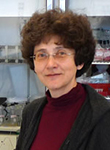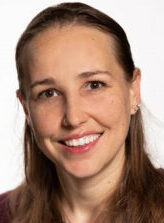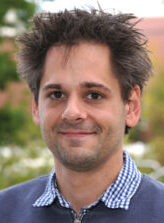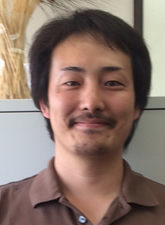Faculty
Training faculty are members of one or more of five partner graduate programs at WSU: Chemical Engineering, Chemistry, Immunology and Infectious Disease Program, Molecular Biosciences, and Molecular Plant Sciences
Many faculty are affiliated with multiple Ph.D. programs or collaborate across WSU colleges. Thus, graduate trainees in any given laboratory may be in different Ph.D. programs, gathering first-hand experience in interdisciplinary collaboration, a feature of contemporary research.
Faculty build skills in mentoring research experiences by exploring mentorship practice in periodic Faculty Forum meetings.
Prospective and new trainees are encouraged to contact faculty members directly to discuss research opportunities. Our trainers are committed to helping new trainees find projects and mentorship that best fit their interests and goals.

Faculty Member List
Bolded names indicate members of the Executive Steering Committee
Jump to:
Chemistry
Chemical Engineering and Bioengineering
Immunology & Infectious Diseases
- Arden Baylink
- Santanu Bose
- Kelly Brayton
- Douglas Call
- Bonnie Gunn
- Tom Kawula
- Michael Letko
- Anthony Nicola
- Anders Omsland
- Stephanie Seifert
- Dana Shaw
- Viveka Vadyvaloo
Molecular Biosciences
- Ryan Driskell
- Sascha Duttke
- Alan Goodman
- Kanako Hayashi
- James MacLean
- Heather Koehler
- Nathan Law
- Steven Roberts
- Bertrand Tanner
- Jennifer Watts
- John Wyrick
Molecular Plant Sciences
- Laura Bartley
- Phil Bates
- Asaph Cousins
- David Gang
- Cynthia Gleason
- Hanjo Hellmann
- Helmut Kirchhoff
- Mark Lange
- Norman Lewis
- Michael Neff
- Cecilia Rodriguez Furlan
- Karen Sanguinet
- Andrei Smertenko
- Camille Steber
- Kiwamu Tanaka

Program Director:
Douglas Call
My research program encompasses a broad range of topics that are related to antimicrobial resistance. Activities associated with the Protein Biotechnology Program include studies of specific antimicrobial peptides to understand the mechanism of action against a diversity of important bacterial pathogens. We are now working on models for predicting activity of AMPs against different host cells and pathogens with the goal of employing these findings to rationally design new AMPs that have more desirable properties. My lab recently characterized the mechanism of action and gene regulation for a novel microcin that has potential as a therapeutic against antibiotic-resistant and pathogenic strains of E. coli and Shigella. We are also investigating the catalytic efficiency and expression dynamics of different beta-lactamase enzymes to understand how bacteria with one enzyme (CTX-M-15) can gain prominence in food-animal populations over bacteria that express another enzyme (CMY-2) that conveys a similar spectrum of resistance to antibiotics.
Research Area: Mechanisms that lead to the emergence, amplification, persistence and dissemination of antibiotic resistance in food animal production systems (E. coli and Salmonella).
Department: Paul G. Allen School for Global Animal Health (SGAH)
Office: Allen SGAH 331
Phone: (509): 5-6313

Member of the Executive Steering Committee:
Cliff Berkman
My research group pioneered the development of small-molecule ligands targeted to the hallmark enzyme-biomarker on prostate cancer cells know as PSMA. These ligands have been outfitted with various payloads including radioisotopes and cytotoxic drugs for diagnostic and therapeutic applications for prostate cancer. Two of these ligands have advanced to clinical trials under the auspices of our biotech startup known as Cancer Targeted Technology.
Department (Mail): Chemistry (4630)
Office: Fulmer 477
Phone: (509): 5-7613

Member of the Executive Steering Committee:
Cynthia Gleason
The projects in my lab center on the biochemistry and molecular biology of plant-nematode interactions. In particular, my lab focuses on nematode protein secretions, called effectors, which are released into plants upon nematode infection and alter the host plant physiology. The nematode effectors we study have been shown to suppress plant defenses. We have also shown that at least one nematode secreted protein affects the host cell cytoskeleton. We are continuing our research on identifying new nematode effectors and their interaction partners in potatoes and other plants. The overarching goal of this research is to better understand nematode biology and how nematodes are so successful at infecting most vascular plants. By investigating nematode effectors and the plant processes they affect, we aim to develop new tools for resistance against root-knot nematodes. Students in my lab learn a variety of protein and molecular biology techniques. The research in my lab involves, but is not limited to, studying protein interaction partners of plant and nematode proteins, and protein analysis of transgenic plants. The training would be useful for students interested in pursuing careers in the Ag-based biotechnology industry.
Department: Plant Pathology
Office: Johnson 335
Phone: 509-335-3742

Member of the Executive Steering Committee:
Playing a critical role in muscle contraction, cell movement, and cell morphology, actin filaments form vastly different structures in different cell types and different locations within the cell. Regulation of the dynamics at actin’s ends is of central importance in the assembly of these various structures. The major goal of our research is to determine the mechanisms of this fine-tuned regulation necessary to understand processes existent in living cells, such as myocytes and neurons. Important part of research in my laboratory is studying structure of proteins and formation of protein complexes as well as engineering proteins with desired properties. In our experiments, we design and refine methods of protein isolation, purification and characterization.
Department: Voiland School of Chemical Engineering and Bioengineering
Office: Wegner 340D
Phone: (509): 5-1888

Member of the Executive Steering Committee:
Viveka Vadyvaloo
Research in the Vadyvaloo lab is broadly focused on understanding the biology of flea-borne transmission of the bubonic plague bacterium, Yersinia pestis, with the intention of identifying novel targets for intervention in prevention of spread of the plague bacterium by flea bite. The lab utilizes numerous biochemical and molecular biology methods to elucidate and functionally characterize the role of bacterial post-transcriptional regulatory proteins and non-coding RNAs involved in adaptation and transmission of Y. pestis from fleas. An example of a post-transcriptional regulator protein that is studied is the highly conserved CsrA protein that controls central carbon metabolism in many Gammaproteobacterial species. CsrA binds to mRNA targets at specific binding sites in untranslated regions of the mRNA. Our current work has identified CsrA mRNA targets and the respective CsrA binding sites in these mRNAs that are involved in development of a transmissible infection from fleas. On-going work tackles how CsrA protein is antagonized by non-coding RNAs to control flea infection metabolism Students enrolled in this program would be exposed to understanding bacterial pathogenesis using molecular approaches and an in vivo flea model.
Department (mail): Paul G. Allen School for Global Animal Health (7090)
Office: Allen SGAH 317
Phone: (509) 5 – 6043

Member of the Executive Steering Committee:
Jennifer Watts
The Watts lab studies how the regulatory actions of specific lipids impact the cell biology and physiology of animals. The implications of this research extend from understanding how specific fatty acids affect cell signaling to dissecting the fat regulatory pathways involved in obesity and cancer. We use the nematode model Caenorhabditis elegans and a combination of genetic, lipidomic, genomic and biochemical approaches to understand the regulation, function, and biosynthesis of unsaturated fatty acids. We discovered that a specific dietary omega-6 fatty acid induces ferroptosis in germ cells in C. elegans and in human cancer cells. Ferroptosis is a regulated form of cell death defined by the iron-dependent accumulation of oxidized lipids in the cell. This research has several connections to protein biotechnology because triggering ferroptosis in tumors has potential to be used as a cancer therapy. Additionally, we are studying whether the manipulation of lipid metabolism in plant parasitic nematodes will lead to a non-toxic form of crop protection and parasitic nematode control.
Department: School of Molecular Biosciences
Office: BLS 433
Phone: 509-335-8554

Understanding and controlling plant metabolic processes and organ cellular architecture toward sustainable production of food, fuels, chemicals, and materials. Target metabolites are abundant plant components including phenolics, such as lignin and tannins; polysaccharides, including xylan; and aliphatics, like suberin. We generate hypotheses through systems biology (e.g., transcriptomics, proteomics, phosphoproteomics) and forward genetics analyses and then test the functions of enzymes and their regulators using in vitro, cellular, and whole-plant assays, key approaches in biochemistry and biotechnology.
Department: Institute of Biological Chemistry

Plant lipids include essential membrane components, signaling molecules, and the most energy dense form of biological carbon storage in the form of oils. For humans, plant oils can provide the essential fatty acids required in our diets and can provide an alternative to petroleum in both the chemical and fuel industries. The Bates lab focus on elucidating the protein components that control carbon flux through the overlapping pathways of membrane lipid and oil production, and control plant oil fatty acid composition which dictates the various uses of different plant oils. Our long term goals are to be able to control both the quantity and fatty acid composition of plant lipids to provide novel plant oil products for use in the food, fuel, and chemical industries.
Department: Institute of Biological Chemistry
Office: Clark 325
Phone: (509) 335-0553

Gastrointestinal bacteria, antimicrobial peptides (including crystallography)
Department: Veterinary Microbiology and Pathology

Work in the Beyenal laboratory focuses on microbial biofilms and bacterial adhesion processes in the context of environmental microbiology and environmental contaminants. Specific research topics in the laboratory include: measuring biofilm parameters with microsensors, microbial fuel cells, electron transfer mechanisms, and bioremediation. Recent work has demonstrated new methods for treating bacterial infections in tissue by altering the growth conditions in situ.
Department (Mail): Chemical Engineering and Bioengineering (6515)
Office: Wegner 355
Phone: (509) 5 – 6607

Respiratory viruses like influenza A virus, respiratory syncytial virus and more recently SARS-CoV-2 cause widespread morbidity and mortality by triggering hyper-inflammation in the lung tissue, which manifests into exaggerated lung disease pneumonia. Pneumonia is the leading cause of death associated with respiratory virus infections. Our research is focused on understanding the mechanisms regulating hyper-inflammation during respiratory virus infection. These studies are important for development of anti-inflammatory therapeutics to control virus-induced pneumonia in the respiratory tract. Thus, our research program has enormous impact the biotechnology field in terms of development of anti-pneumonia therapeutics to combat severity of respiratory virus infections.
Department: Veterinary Microbiology and Pathology
Phone: 509-335-9413

Research in the Brayton laboratory focuses on vector-borne pathogens. Research on the tick-borne pathogen Anaplasma marginale examines several aspects of infection biology including comparative genomics of vector-borne transmission, elucidation of effectors of the Type Four Secretion System, mechanisms of persistence, and the ability of the microbiome of ticks to affect transmission. Research on the zoonotic pathogen Anaplasma phagocytophilum employs functional genomics and cell biology. We have access to a gene knock-out library, the first of it’s kind for a rickettsial agent, and can use this to explore the function of previously undescribed proteins. We are currently exploring host specific aspects of the Type Four Secretion System and the effector proteins that are translocated through it. These projects all have as a central theme understanding protein function to elicit a specific response.
Department (mail) :VMP (7040)
Office: ADBF 4025
Phone: (509): 5-6340

The Brozik laboratory has special expertise in the interaction of light and matter and has made many contributions to single molecule imaging, spectroscopic imaging, fluorescence microscopy, spectroscopy, optical design and fabrication, chemical synthesis, molecular cell biology and protein purification, and biomimetic self-assembly. A recent focus has been on developing methods for membrane protein expression, purification, and functional reconstitution into biomimetic assemblies. This work has enables single molecule imaging methods that are able to track membrane proteins involved in redox reactions and measure their dynamics in biomimetic assemblies with subdiffraction limited physical resolution and 10ms temporal resolution.
Department: Chemistry (CHEM)
Office: Fulmer 123
Phone: (509): 5-3746

The vast majority of biochemical analysis techniques occur in solutions due to the tractable importance of in situ experiments. However, merit exists in probing the subtleties of biopolymer chemistry and dynamics in the gas phase. When paired with solution-phase analogs, gas-phase experiments provide high-resolution information related to metabolic function (e.g., stable isotope probes), foundational data for computational efforts, and yield unparalleled information regarding quality control for synthetic biology. Using a range of gas-phase separation and analysis techniques (e.g., ion mobility and mass spectrometry), the Clowers Research Group at Washington State University develops advanced chemical instrumentation and associated methodologies that capture salient molecular size and mass differences. Relevant focus areas include the thermodynamics of biopolymer unfolding, isotope probing of solvent-accessible surfaces, and evaluation of post-translational modification sites.
Department: Chemistry (CHEM)
Office: Fulmer 549
Phone: (509) 335-4300

Nearly all photosynthetic organisms initiate the capture of atmospheric carbon with either ribulose-1,5-bisphosphate carboxylase/oxygenase (Rubisco) directly fixing CO2 or by phosphoenolpyruvate carboxylase (PEPC) fixing carbon as bicarbonate. However, these enzymes have inherent kinetic tradeoffs that limit their catalytic efficiency, or the rate at which they fix carbon, under current and expected atmospheric CO2/O2 concentrations and temperatures. The Rubisco carboxylation rate is often competitively inhibited by oxygen and there is a kinetic trade-off between Rubisco’s catalytic rate and affinity for CO2 (i.e., faster enzymes have lower affinity for CO2 and vice versa). Alternatively, PEPC fixes bicarbonate instead of CO2 and is insensitive to oxygen. This oxygen insensitivity increases the carboxylation efficiency of PEPC compared to Rubisco but there is a kinetic trade-off between PEPC’s affinity for bicarbonate and its other substrate phosphoenolpyruvate (PEP). For Rubisco and PEPC, these trade-offs are determined by reaction mechanisms that define their kinetic properties for how quickly they catalyze carbon fixation (turnover rate) and their affinities for their substrates CO2 and bicarbonate, respectively. To engineer an increase in the catalytic efficiency of Rubisco and PEPC to help meet globally increasing bioenergy demands will require a better understanding of these enzymes’ kinetic trade-offs. Therefore, it is important to understand the reaction mechanisms determining the kinetic trade-offs of Rubisco and PEPC to optimize their catalytic efficiencies so photosynthetic organisms can better utilize light energy to capture atmospheric carbon for energy storage.
The long-term goal of our research is to determine the mechanisms controlling the acquisition, uptake, and photosynthetic reduction of CO2 into organic compounds. Specifically, the overall objectives of this proposal are to 1) resolve which reaction rates determine the kinetic trade-offs between Rubisco carboxylation and oxygenation reactions, 2) determine if the temperature response of Rubisco kinetics is due to lower CO2 affinity or more efficient oxygenation reactions, 3) determine the trade-offs of PEPC affinity for PEP and bicarbonate, and 4) identify amino acid residues that control the kinetic properties and allosteric regulation of PEPC. Our membrane inlet mass spectrometer can directly measure enzymatic rates of CO2, bicarbonate, and oxygen consumption to derive Rubisco and PEPC enzyme kinetics and isotope fractionation. We have a diverse seedstock for plants with known variation in Rubisco carboxylation kinetics and a well-established Escherichia coli heterologous expression system to generate high concentrations of Rubisco and PEPC isoforms from diverse species.
Program: Molecular Plant Sciences
Department: School of Biological Sciences

Our multi-disciplinary research program includes 1) understanding the Ca2+ switching mechanism of cardiac myofilament in healthy and diseased hearts, 2) developing various paper-based sensing technologies for detections of proteins, nucleic acids and exosomes as disease biomarkers of heart diseases, cancers, bacterial/viral infectious diseases, and 3) exploring the use of exosomes as novel antibiotics to address current issue of antibiotic resistance that lead to higher medical costs, prolonged hospital stays, and increased mortality with many bacterial infection diseases. Working with these projects will enable students to learn broad research techniques and approaches from protein bioengineering techniques, molecular cloning, cell culture, muscle mechanics, various optical and spectroscopic technology, sensor developments and engineering design and fabrications. During their training, students will also be able to acquire depth knowledge in the fields of protein biochemistry, molecular genetics, muscle physiology and mechanics, optics and spectroscopy and biophysics. These training and knowledges are important for whose who want work in both industrial sectors and academia for their future career development.
Department: Voiland School of Chemical Engineering and Bioengineering and Integrative Physiology and Neuroscience
Office: VBRB 271 or Wegner 109
Phone: (509): 5-5798 or 5-8684

The prevailing theory of the Driskell Laboratory is that humans have the potential to functionally regenerate skin but for some reason our wounds heal with a scar. Research has shown that very young skin can partially regenerate, which is an ability lost shortly before birth. Consequently, comparing the molecular and cellular properties of young skin to old skin will provide a genetic blueprint to possibly reverse skin aging and to achieve regeneration. Projects in the Driskell Laboratory involve a multi-disciplinary approach utilizing next generation sequencing technology and computational biology techniques to compare young and old skin. For example, performing single-cell-RNA-sequencing, single-cell-ATAC-sequencing, and spatial transcriptomics to compare young and old skin samples. The lab also utilizes transgenic model systems to test if activating newly identified ‘young genes or cells’ in adult tissue will reverse or inhibit skin aging and support regeneration.
Department: School of Molecular Biosciences
Office: BLS 233
Phone: 509-335-5614

Many biological phenomena, including numerous human diseases, can be traced to the proper or improper expression of a gene or genomic locus. Hence, knowledge of the mechanisms that interpret our genome is essential for the successful analysis of a wide range of biological and biomedical topics. For example, most sequence variants associated with human disease risk or drug resistant pathogens reside in promoter or enhancer regions, rather than coding DNA. A major limitation to understanding gene regulation is our inability to predict functional gene expression programs from DNA sequence or open chromatin, a task that is readily performed in our cells by transcription factors (TFs). Thus, analogous to vocabulary when learning a language, understanding TFs and their ‘grammar’ is central to interpreting our genome. To characterize TFs function and networks, my research combines bioinformatic, comparative and biochemical approaches with nascent transcriptomics such as our recently developed capped small RNA-seq (csRNA-seq), which captures initiated transcripts from total RNA and thus enables the analysis of any fresh or frozen tissue of interest. TFs regulate crop size, the response to stimuli and over 95% of sequence polymorphisms associated with human disease map to areas of TF binding, rather than genes themselves. Understanding collaborative TF action also holds a key to understand and predict the differential response to challenges or treatment – or why some of us get sick or respond to a treatment why others don’t? It is therefore critical to establish a paradigm for how TF spacing and differential collaboration interprets our genome.
Department: School of Molecular Biosciences

The Gang laboratory expertise is in the areas of metabolomics and proteomics, including protein and metabolic pathway analyses and engineering. One specialty is analysis of specialized tissues and cells in diverse species. Dr. Gang is Co-Director of the Murdock Metabolomics Laboratory and the Director of the Tissue Imaging and Proteomics Laboratory at WSU, and is CSO of Botanisol, a company that is interested in the effect of plant products on health.
Department:Institute of Biological Chemistry (IBC)
Office: Clark 385
Phone: (509): 5-0550

Research in the Goodman laboratory focuses on host responses to viral and bacterial infections, specifically West Nile and Zika viruses and Coxiella burnetii. We use the Drosophila melanogaster model as a screening tool to discover novel gene variants that regulate these pathogenic infections. Work in the lab has led to the establishment of the fruit fly as a model for C. burnetii infection and the identification of several genes that regulate host mortality to infection. Additionally, using fruit flies and mosquitoes, we identified that insulin receptor signaling restricts West Nile virus infection in these animals. Our lab provides opportunities for undergraduates, graduate students, and post-doctoral fellows to characterize the function of the genes we identified that regulate C. burnetii infection and to determine how insulin signaling in mosquitoes affects adaptive mutations in West Nile virus, behavior and lifespan of the mosquito, and transmission and disease in mammals. Our long-term goal is to develop protein biotechnological methods to reduce pathogen levels in animals carrying these viruses or bacterial so that transmission rates and disease incidence is lowered in humans.
Department: School of Molecular Biosciences (SMB)
Office: BLS 135
Phone (509): 5-4104

My research program at Washington State University is focused on defining mechanisms of antibody-mediated immunity against zoonotic infectious pathogens in both humans and reservoir animal species. We use a suite of immunological assays to determine the quantitative and qualitative features of humoral immunity that may track with distinct disease outcomes or protection, including measuring levels of pathogen-specific antibodies and analysis of antiviral functions of antibodies such as neutralization and induction of innate immune effector functions such as phagocytosis and ADCC. We use antibody engineering tools to mechanistically dissect the role of specific antibody functions in immunity that can help in the design of vaccines and antibody-based therapeutics. Our trainees within the NIH-Biotechnology program learn to integrate biological analyses of complex immunological interactions with biotechnology approaches to develop new strategies to tackle infectious disease across the globe.
Department (mail): Paul G. Allen School for Global Animal Health (7090)

The Hayashi Lab focuses on discovering and understanding the cellular, molecular and epigenetic mechanisms of gynecological diseases and reproductive functions influenced by environmental toxicants, as well as developing novel therapeutic strategies that are more effective than those currently employed by the medical community. Especially in the endometriosis study, we are currently investigating immune dysfunction in the disease initiation, establishment and progression, as well as developing new innovative therapies to improve health outcomes of patients with endometriosis through inhibition of inflammatory mechanisms. We also focus on the transgenerational effects of environmental toxicants such as bisphenol A (BPA) and BPS, and recreational drugs such as cannabis on male and female reproductive functions. Key Words and Techniques: Drug Development, Endometriosis, Translational Studies, Environmental Toxicants (BPA/BPS), Recreational and Medical use of Cannabis, Animal Models/Transgenic Mice, Immune Cells, Bioinformatics, Single-cell analyses (scRNA-seq/scATAC-seq), Next-Generation Sequencing (NGS), Cellular and Molecular techniques.
Department: School of Molecular Biosciences
Office: BLS 345
Phone: 509-335-7022

My research focusses primarily on processes related to protein degradation that are
facilitated by the ubiquitin proteasome pathway (UPP), a highly conserved regulatory
mechanism among eukaryotes. Processes we are interested in as a group are related to how
protein turnover affects developmental stages in plants, such as flowering time or embryo
development, as well as abiotic stress responses, such as salinity or temperature stress. Our
research also corresponds to several phytohormone pathways, mainly ethylene, abscisic acid
and brassinosteroid signaling. My secondary research topic is on uncovering the regulatory
steps in vitamin B6 biosynthesis. Our current model indicates that lysosomal and autophagic
steps are involved in controlling the half-lives of vitamin B6 biosynthesis proteins in plants,
which brings a novel aspect to this field.
Program: Molecular Plant Sciences
Department: School of Biological Sciences

Kang is the Director of the WSU X-ray Crystallography Center, which trains over 50 graduate and undergraduate students per year to use various physicochemical instruments, including crystallography for both macro and small organic molecules. The Kang group is trying to understand fundamental catalytic reaction mechanisms and define substrate/product specificity of the enzymes in biodegradation pathways for various xenobiotic pollutants, especially pentachlorophenol (PCP). Trainees in this laboratory will not only first-rate training in the rapidly expanding field of structural biology but will become exposed to biochemical, genetic, and biophysical expertise.
Department: Chemistry
Office: Fulmer 264
Phone: (509): 5-1409

The Kawula laboratory is focused on understanding how intracellular pathogens disarm or evade host defenses and alter host cell processes to acquire essential nutrients. Many research projects focus on effector protein expression, secretion and binding to host target proteins in order to interfere with host signal cascade proteins or mimic host cell enzymes. A particular target is an autocatalytic autotransporter protein that interferes with endosome maturation to autophagic vacuoles, blocking a pathway that normally is involved in stopping bacterial spread.
tom.kawula@wsu.edu
Department: School of Global Animal Health
Office: Allen SGAH 101
Phone: (509): 5-2489

The Kirchhoff lab has an internationally strong reputation in uncovering design principles of photosynthetic thylakoid membranes in chloroplasts. We combine advanced structural (microscopic) and spectroscopic techniques with a broad set of biochemical assays and computer modeling to obtain a detailed picture of the photosynthetic apparatus that ranges from single molecules (nanometer level) to whole membranes (micrometer level). The overarching goal is to establish a holistic experimental-based multiscale model of structural dynamics of the thylakoid membrane network that predicts how the energy converting machinery in plants functions, is regulated and maintained. Gathering this information is crucial to understand how plants thrive and survive in a complex and highly fluctuating environment.
Department: Institute of Biological Chemistry (IBC)
Office: Clark 427A
Phone: (509): 5-3304

Z-form RNA(Z-RNA) is an ancient molecular pattern distinguished as a duplex of complementing strands configured in a left-handed helix that has recently been identified as a pathogen associated pattern that is associated with viral pathogenesis. The left-handed rotation induces a unique zig-zag arrangement of the phosphate backbone that is structurally distant from the conventional double stranded(ds)RNA(A-RNA) or dsDNA (Watson-Crick B-DNA). Like A-RNA, Z-RNA is recognized by the host cell with innate immune sensors that unleash host defense pathways to restrict the invading pathogens. We have recently demonstrated that the mammalian protein known as Z-form nucleic acid binding protein 1 (ZBP1) is a specialized pathogen sensor that recognizes Z-RNA during the early stages of a viral infection and triggers an explosive caspase independent and inflammatory programed cell death pathway known as necroptosis which eliminates infected cells. Using vaccinia virus (VACV, the prototypic model and vaccine strain used to eradicate smallpox), we have identified a virus encoded mechanism that antagonizes Z-RNA activation of ZBP1 to suppress the activation of necroptosis. Although Z-RNA was first described decades ago, our basic understanding of its purpose remains rudimentary. In recent years, we have come to understand that Z-RNA-induced necroptosis is an inherent inflammatory process induced by viral exposure, but how these cell death and pathogenic insults converge to shape immune responses remains a mystery.We have a clear understanding that Z-RNA is a potent trigger needed to control virus infections and this pathway can be exploited for developing antiviral therapeutics. The potential impact of outcomes from our investigations is the ability to enhance vaccine potency and ameliorate adaptive immunity. We believe, deepening our knowledge of the of Z-RNA:ZBP1 interaction has significant promise for expanding the understanding of the role necroptosis plays in the immune responses to viral infections but more importantly its role as a fundamental regulator of inflammation and infection.
Department: School of Molecular Biosciences

Research in the Lange laboratory focuses on unraveling pathways that lead to the formation and accumulation of plant natural products. We are particularly interested in metabolism in specialized cell types, tissues and anatomical structures, such as glandular trichomes and resin ducts. We study metabolism at all levels, including anatomy, physiology, regulation, molecular biology, enzymology, and mathematical modeling. Protein structure-function studies have focused on terpene synthases, cannabinoid synthases, and functionalization enzymes involved in the biosynthesis of terpenoids, the largest class of plant natural products. Our research has been the basis and inspiration for two biotechnology start-up companies, Ajuga Biosciences (2009 – 2013) and Dewey Scientific (2019 – present).
Department: Institute of Biological Chemistry (IBC)
Office: Clark 341
Phone: (509): 5-3794

Research in the Law laboratory focuses on male germline development, including the formation of germline stem cells, the mechanisms that balance stem cell fate and function, and inheritance through the paternal germline. During germline development, cellular fate and function are dynamically regulated at the transcriptional, epigenetic, and cell signaling levels. Thus, we primarily utilize the mouse as a model of human development and harness the power of modern scientific approaches, such as transgenic mouse technologies, single-cell ‘omics, stem cell culture, and transplantation, to answer some of the most complex questions in germline development. Our basic discoveries are aimed at enhancing the future development of diagnostic or corrective measures to treat infertility and understand what paternal influences are inherited by the next generation.
Department: School of Molecular Biosciences

Using next generation technologies, researchers around the globe are discovering sequences for novel viruses in wildlife. Methods to study these viruses in the laboratory are either non-existent or cost-prohibitive to studying more than a few viruses in any given study. The Laboratory of Functional Viromics is building safe, novel, scalable experimental approaches to study uncharacterized viruses in the laboratory. Our research is focused on producing time- and cost-effective solutions to molecular screening assays. We used our SarbecoType platform to test cell compatibility of novel coronaviruses that have been found in throughout Asia, Africa and Europe, identify the host receptor for SARS-CoV-2, and screen for vaccine resistance of newly discovered viruses. Our latest MerbecoType platform will allow us to explore the large number of animal viruses related to MERS-CoV for their risk to humans. These findings have advanced our understanding of the virome and have been instrumental in the development of universal vaccines.
Department: Allen School for Global Health

A significant portion of our research program is devoted towards elucidating how structurally complex plant-derived medicinals are biosynthesized in vascular plants. One emphasis is on unravelling the enigmatic biosynthetic pathways to widely used medicinally important and health-protecting plant medicinals, and ultimately how this knowledge can be used to biotechnologically tailor dirigent proteins (that we discovered) and associated proteins for specific medicinal/health protection purposes. Our synergistic and long-standing research collaborations at PNNL and Stanford SSRL also further enhance our capabilities through, as examples, molecular modeling of substrate conversions in dirigent-like proteins to probe their active site biochemical mechanisms, as well as via structural biology approaches (NMR and X-ray crystallography), i.e. to establish the nature of dirigent protein-ligand interactions. We have not only delineated DP biochemical functions in this way, but have also obtained the first 3D structures of various dirigent proteins and determined their corresponding biochemical mechanisms. There remains considerable work remaining to be done in this medicinally important area.
Department: Institute of Biological Chemistry (IBC)
Office: Clark 467A
Phone: (509): 5-2682

The MacLean lab studies molecular networks that control mammalian reproduction. We use transgenic mouse models to investigate the role of Reproductive homeobox X-linked (RHOX) transcription factors in gonad development and fertility. These factors are regulated in a tissue and cell-type-specific manner by hormone receptors (AR, PGR, ESR1, etc.). We know that the loss of either RHOX5 or RHOX8 results in decreased spermatogenesis but the molecular mechanism responsible is still unclear and their role in female reproduction remains to be examined.
Department: School of Molecular Biosciences
Office: BLS 347
Phone: 509-335-2533

The Neff lab uses molecular, genetic and biochemical approaches to uncover and describe the interactions between various signaling pathways that modulate plant development. Specifically, they use seedling development in the plant Arabidopsis as a tool for addressing the question: How do signaling pathways modulated by light interact with each other and with those regulated by endogenous hormones to control plant development? Arabidopsis is perfect for this approach due to its small size, rapid lifecycle and completely sequenced genome. Neff’s research relates to the goal of increasing yield in agricultural crops by studying the photomorphogenic and hormone signaling pathways that regulate plant stature.
Department: Molecular Plant Sciences
Office: Johnson 371
Phone: (509): 5-7705

Research in the Nicola lab is centered on elucidating the virus-host interactions during herpesvirus entry into target cells. Herpesviruses, including the human herpes simplex virus, remain significant causes of morbidity and mortality worldwide. The array of more than twelve distinct envelope proteins on the surface of the virus are responsible for critical events in viral entry. The virus interacts with key host cell protein receptors, including the intercellular adhesion molecule nectin-1 and the tumor necrosis factor superfamily member HVEM. Membrane fusion is mediated by a complex of at least four viral glycoproteins including the core fusion protein glycoprotein B. A detailed molecular understanding of the functions of virus and host cell proteins and how they interact during these earliest stages of herpes infection facilitates the development of novel intervention approaches (antiviral drugs and vaccines).
Department: Veterinary Microbiology and Pathology (VMP)
Office: Bustad 315
Phone: (509): 5-6003

Research in my laboratory is focused on bacterial obligate intracellular parasites with particular emphasis on how parasite physiology, metabolic capabilities and requirements shape host-parasite interactions. Coxiella burnetii, the cause of human Query fever, and Chlamydia trachomatis, a leading cause of sexually transmitted infections, form the basis of my research program. Both C. burnetii and C. trachomatis undergo transitions between replicative and non-replicative cell forms via so-called morphological transitions. We use chemically induced expression of specific target proteins to identify genes/proteins that regulate bacterial morphological transition. Additionally, to identify nutrients that serve as signals for bacteria to initiate replication, pathogen responses to nutrient availability is tested via incorporation of radiolabeled amino acids into bacteria proteins, a measure of biomass production.
Department: Paul G. Allen School for Global Animal Health (SGAH)
Office: Allen SGAH 315
Phone: (509): 5-3916

Food and energy crops face increasingly challenging growth conditions that constrain development and negatively impact yield. At the cellular level, plants overcome stress by directing rapid degradation of key components through endocytic and autophagic processes. RAB7 proteins serve as ON/OFF switches, balancing both pathways, which is crucial for survival. When RAB7 is turned from OFF to ON, it can interact with different proteins or ‘interactors’ regulating their biological activity. Our research is dedicated to comprehensively understanding the plant RAB7 protein interactome at distinct organelles, cell types, and cellular processes using a combination of proteomics discovery and molecular and biochemical tools.
Department: School for Biological Sciences and Molecular Plant Sciences Program
Office: Abelson 338

Using developmental, genetic and genomics approaches, the Sanguinet laboratory studies how morphology is influenced by internal and external cues in determining root architecture of temperate grasses like those of barley and wheat. Through characterization and analysis of a suite of root mutants and natural accessions in the model grass Brachypodium distachyon, we are quantitatively and qualitatively investigating the control of branching and elongation and resource allocation. We are also interested in the link between hormonal activity and cell wall constraints on morphogenesis
Department (mail):Department of Crop and Soil Sciences (6420)
Office: Johnson 255
Phone: (509) 5 – 3662

DNA circuits and liquid chemical computers
Department (mail): Chemical Engineering and Bioengineering (6515)

Graduate students in the Seifert lab can pursue both laboratory and computational projects. In the laboratory, students can develop novel approaches to improve detection of viruses in clinical and ecological samples including custom Luminex multiplexed serological assays targeting diagnostic-informative viral proteins or nucleic acid target enrichment approaches and next generation sequencing platforms to detect viral genomes. On the computational side students will apply machine learning and network analyses to predict zoonotic risk with known and novel viruses from -omics data. Datasets include proteomics data collected through tandem mass spectrometry for data-independent acquisition and metaproteomic techniques to study the innate immune response of nonmodel organisms (bats and wild rodents) to viral infection.
Department: Allen School for Global Health

The Sharma Lab is a Translational Nanomedicines Research Laboratory working at the interface of chemistry, nanotechnology, and biology to develop disease-directed nanomaterials to address unmet medical needs. The clinical translation of nanotherapeutics is hindered due to their complex inherent design and inadequate accumulation at desired targeted locations. Toward this goal, The Sharma Lab is developing clinically relevant biocompatible, smart, and scalable nanomaterials by incorporating all the essential elements for clinical translation during the material design itself. The goal is to fabricate cell-targeted nano-interventions capable of delivering drugs specifically to injured cellular and intracellular locations across multiple biological barriers. The targeting to specific cell-types is accomplished by utilizing dendrimers mediated multivalent ligand-protein interactions on cell surfaces. The major research areas in the lab include: 1) Asialoglycoprotein receptors targeted nanomedicines for delivery to hepatocytes; 2) Prostate-Specific Membrane Antigen (PSMA) and galectins targeted dendrimer nanomedicines for cancer; and 3) Glyco-dendrimers based nanotherapies for the treatment of ocular diseases and brain diseases.
Department: Chemistry

In 2018, 90% of all vector-borne disease cases reported to the CDC were attributable to ticks. My lab focuses on elucidating molecular mechanisms influencing the ability of ticks to harbor and transmit disease. How arthropod immunity responds to transmissible microbes is a fundamental factor influencing vector competence. Projects in my lab center on crosstalk between stress responses and arthropod immunity. Cellular stress-responses are closely intertwined with immunity and can function to either potentiate or antagonize immune signaling. We are pursuing projects that examine the unfolded protein response (UPR) and the Integrated Stress Response (ISR). We integrate methodologies in microbiology, biochemistry, genetics, structural biology and organismal biology to elucidate new concepts in arthropod immunity and vector competency. Techniques include gene silencing, protein expression, protein-protein interactions and protein localization. Given that crosstalk between cellular stress responses and innate immunity is likely an ancient mode of pathogen-sensing and host defense against many types of microbes, we expect that our findings may have broad relevance to many vector-pathogen systems.
Department: Veterinary Microbiology and Pathology
Office: ABDF 4031
Phone: 509-335-3884

Our lab works on the rules of tissue engineering and abiotic stress resiliency in plants. Engineering of tissues offer enormous agricultural and societal benefits. However, despite significant progress in understanding the upstream signaling events that govern tissue engineering, the effector proteins remain poorly characterized. At the heart of the plant tissue engineering are two fundamental processes: orientation of cell division plane and cell expansion. Our team works on mechanics of cell division; regulation of cell architecture; and cross talk between cytoskeleton and the cell wall. Once the tissue engineering process is accomplished, plants frequently deal with the detrimental environmental conditions. The second direction focuses on identification of proteins responsible for the cellular mechanisms of drought and heat response and exploiting this knowledge for improving plant resiliency. We use protein biochemistry, protein engineering, molecular biology, genetics, plant stress physiology, microbiology, Total Internal Reflection Fluorescence Microscopy, Laser Scanning Confocal Microscopy, and image analysis techniques.
Department: Molecular Plant Sciences
Office: PSB
Phone: 509-335-5795

Department: Molecular Plant Sciences Program
Phone: 509-335-2887

Research in the Tanaka lab focuses on innate immune signaling in response to plant pathogens and pests. One focus of study is extracellular ATP as a damage-associated molecule. ATP is well-known as an energy currency, but once ATP is released following cellular damage, it acts as a damage signal. Their discovery of the plant receptor for extracellular ATP has opened the way for in-depth study of this danger signal and has expanded the understanding of defense signaling networks and mechanisms of plant innate immunity. They also interested in nontoxic, naturally occurring compounds that contribute to the induction of plant defense responses. These compounds can be used as immunostimulants for plant protection and serve as an alternative to traditional pesticides. Their research program integrates molecular biology, genetics, and plant pathology to understand how plants fight against pathogens and pests.
Department (mail): Plant Pathology (6340)
Office: Johnson 355
Phone: (509) 5-6418

My laboratory studies cardiac and skeletal muscle biology underlying physiological function and pathophysiological dysfunction. We focus on mechanical and biochemical mechanisms that enable the motor protein myosin, and it’s highly structured network in the cell, coordinate contractility to power blood flow and locomotion. My background in physics, bioengineering, computational biology, and biomechanics all come together to tackle difficult and interesting questions about normal and diseased muscle function from the protein to the tissue level. Protein activity and regulatory interactions within the sarcomere enable an amazing variety of muscle functions. I’m hopeful that defining how different components of the system operate as a whole will ultimately guide innovative approaches to ameliorate dysfunctional contraction with disease.
Department (mail): Integrative Physiology and Neuroscience

Research conducted by Prof. Bernie Van Wie and his team fit the NIH Protein Biotechnology theme as we are: 1) exposing chondrocytes and mesenchymal stem cells to shear, stretching, oscillating hydrostatic pressure, growth factors and nutraceuticals to differentially upregulate mRNAs for manufacture of proteins to be secreted that are important for robust articular production, i.e., collagen type II and aggrecan, and to downregulate catabolic mRNA indices; 2) growing cytotoxic T-cells in a centrifugal bioreactor in ways that expand the culture while maintaining the cytotoxic phenotype and diminish T-cell exhaustion as evidenced by expression of appropriate cell surface maker proteins; and 3) developing new nanoparticle enhanced immunoassays for proteins of interest, e.g., collagen type II.
Department (mail): Chemical Engineering and Bioengineering (6515)
Office: Wegner 311
Phone: (509) 5 – 4103

My laboratory studies how proteins bound to DNA modulate the formation and repair of DNA damage. We are particularly interested in how repair proteins work to access DNA damage in the context of DNA packaged into chromatin. We have previously shown that DNA-bound transcription factor proteins significantly modulate the formation of UV damage by altering the structure of the DNA at their binding sites. In the case of ETS family transcription factors, this results in a significant elevation of UV damage at ETS binding sites, which translates to a very high rate of mutations at ETS binding sites in skin cancers. Ongoing studies are examining how other transcription factor proteins, as well as nucleosomes, modulate UV damage formation, repair, and mutagenesis in skin cancers.
Department: School of Molecular Biosciences
Office: BLS 241
Phone: 509-335-8785